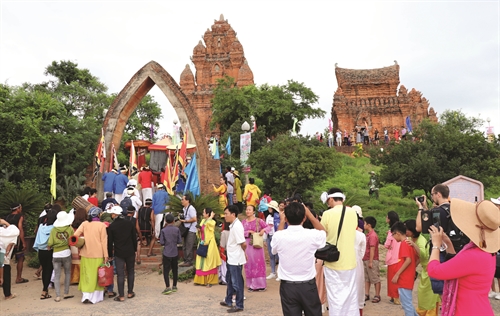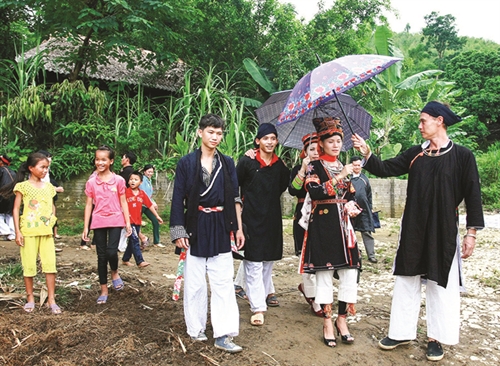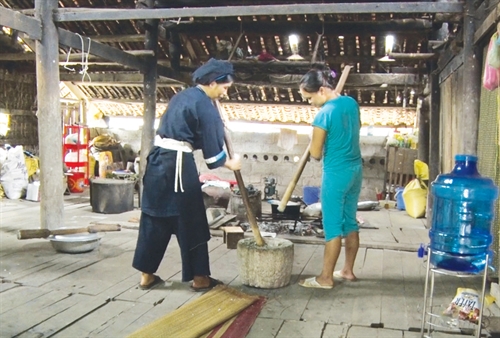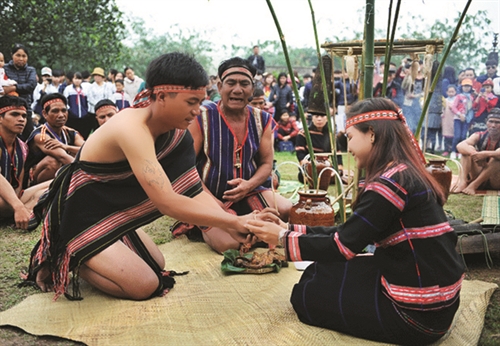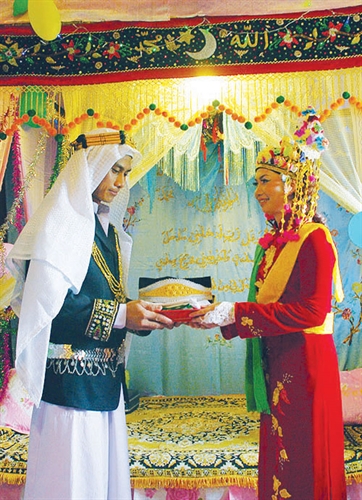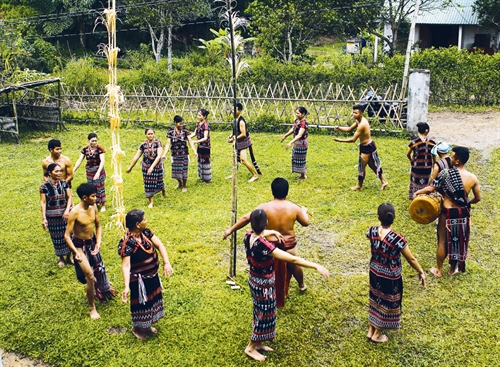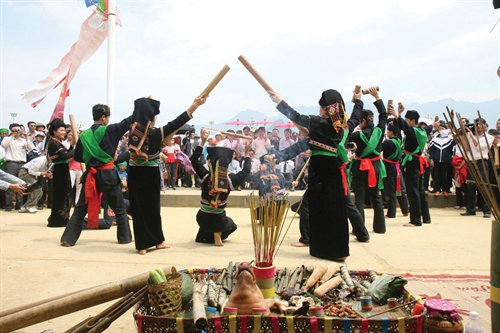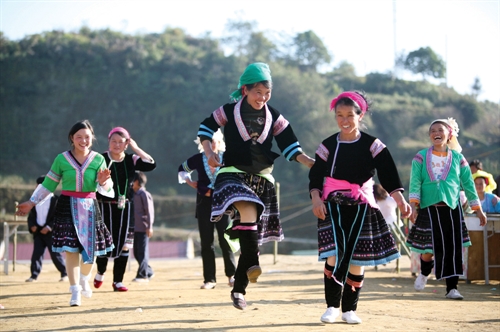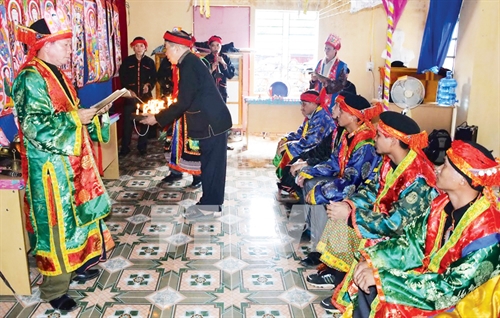Ta Thi Tam, M.A.
Institute of Anthropology
Vietnam Academy of Social Sciences
The Nung Phan Slinh is one of three main subgroups of the Nung, an ethnic minority group of the Tay-Thai language living mostly in the northern mountainous provinces of Lang Son, Bac Giang and Cao Bang. The group’s customs of celebrating birthdays for elderly people not only show their filial piety but also reflect their spiritual life and more or less reveal information about their history and culture.
The Nung Phan Slinh believe that each person has three souls, called sli. If the souls of a person leave the body, that person will be ill and then die. On the contrary, a person may recover from serious illness if his family invites a sorcerer, called thay Tao, to call his wandering souls to come back. In the Nung Phan Slinh’s belief, the Jade Emperor grants a certain amount of food to everyman for use throughout his life and such food will run out when a man reaches the age of 60. Also, when a man gets old, his souls will become weak and he will easily fall ill. Thus, his children have to organize two rituals, one is a birthday ceremony, called van khoan, to find his wandering souls, and another is a ritual, called pu giao pu luong, to add more rice to the amount of food granted by the Jade Emperor. The two ceremonies are organized every five years by the children who live with the parents with contributions of other children who have their own families and live far away from them and the attendance of their relatives and neighbors.
A family that wishes to organize van khoan and pu giao pu luong rituals has to ask a sorcerer to choose a good day from the last three months of the lunar calendar. One day or two days before the rituals, the host of the rituals will send a family member to give the main sorcerer some traditional handmade papers, called giay ban, colored papers and papers written with the name, date of birth and address of the parent and the host who organizes the rituals for his parent.
On the day the rituals are conducted, after dinner, the host will put a boiled rooster on the right side of the lowest of the family three-tier altar, which is reserved for Ba Mu - the spiritual midwife who gives shape and protects the family’s babies. He will also place a roasted pig head on the ancestors’ tier of the altar, which is just above Ba Mu’s tier. It is worthy to note that every Nung Phan Slinh family has a two-tiered altar placed in the middle of the house to worship the Buddha and the subgroup’s forefather on the upper tier and their ancestors on the lower tier. The third tier, Ba Mu’s tier, is added when the family’s first baby reaches one month old.
A tray of offerings with five invitation letters prepared and written by the sorcerer in Chu Nom (Chinese-like scripts) of the Nung will be put on the ground right underneath the ancestor’s altar. Placed on it are banana leaves that are considered mats, a bowl of rice with three burning incense sticks, three boiled roosters, three bowls of rooster blood, a lamp, candles, chopsticks, cups of wine, bowls and votive papers.
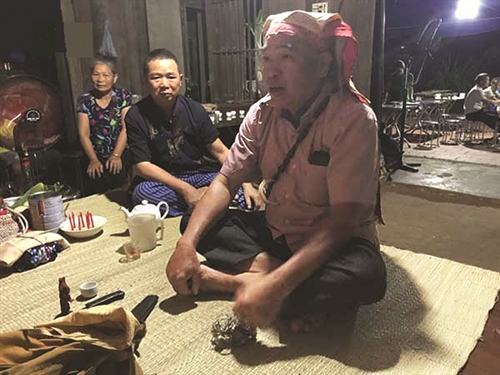 |
| A sorcerer (front) performs ritual formalities at a birthday ceremony of a Nung man__Photo: Internet |
Van khoan and pu giao pu luong rituals are often conducted by two sorcerers, a main sorcerer and a younger sorcerer acting as the former’s assistant. To prepare for the ceremony that starts at exactly 10pm, the main sorcerer takes out of his bag a worship book, two ying-yang wooden pieces, called phu cao, a wooden ruler, called teo slao ca, a pair of scissors and a wooden monkey, called ho lo, and then pours wine. Commencing van khoan, the sorcerers put on their ritual costumes and hats. The main sorcerer clamps a wooden ruler to incense sticks vertically and moves them along the book from right to left to invite their deceased senior sorcerers to examine their work and incites incantations over the bell and the bowl of water which is later splashed into four directions to ask for the latter’s permission to conduct the ceremony. One sorcerer will open invitation envelopes while the other will read out the invitation letters one by one to invite their deceased senior sorcerers and deities to the ceremony. While burning the invitation letters and envelopes, the assistant sorcerer bends down and drops two ying-yang wooden pieces clamped to the wooden ruler on the floor to ask for permission. During the invitation rite, both sorcerers say their prayers while the bell is rung.
The main sorcerer has to ride a horse to cross the bridge to find wandering souls. A white piece of cloth regarded as a bridge is stretched over the table and four paper horses used by the main sorcerer to find wandering souls are put on a red piece of cloth which symbolizes the road. During the search for wandering souls of the host’s parent, the main sorcerer sits facing the entrance door and holding the wooden ruler behind his back while reading out his worship book. Whenever he turns the page, he hits the wooden ruler with the wooden monkey and votive papers considered money used during the way are taken away to be burnt. Sometimes he rings the bell to signal he is crossing a crossroad.
After the souls return home, the assistant sorcerer puts them in a traditional handmade paper which is kept in the main sorcerer’s right jacket pocket. The soul-searching ritual is concluded with the burning of a small traditional handmade paper written with the date of birth and address of the host’s parent, a black paper keeping the remaining souls of the host’s parent and the paper keeping the returning souls.
Then the pu giao pu luong ritual starts. The host prepares three roosters and a lighted lamp for the offerings and puts a basket of rice made of paper or red cloth near a large flat drying basket on the left of the sorcerer’s seat, a large bowl with some water in the middle of the larget flat drying basket, and a piece of wood symbolizing a yoke over the bowl to one side of the large flat drying basket. A paper horse is placed on each side of the piece of wood and four others on a small chair. A white piece of cloth is stretched from the main sorcerer’s table to cover the piece of wood and the chair.
The main sorcerer starts the ritual by reciting incantations over a paper horse that is put on his ruler and the name of the yoke’s two ends. The host’s parent then sits on the chair and a family member puts up an umbrella for the parent. After that, the sorcerer places a cup of rice and votive papers on the paper horse which are regarded as the horse bringing food and money to the parent. The ritual is concluded after the main sorcerer offers a cup of wine to the parent and the host burns votive papers and offerings and invitation letters.-
